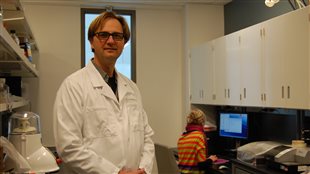Today, March 24th, marks the annual World Tuberculosis Day.
It is a day to raise awareness and promote action against a disease that has lingered far too long in human history. It is a slow, debilitating disease that kills about a million and a half people world-wide every year.
Dr Marcel Behr (MD, MSc) is a professor of medicine at McGill University, Director of McGill International TB centre, and a researcher in the Molecular Epidemiology of Infectious Diseases Montreal General Hospital.
Listen
For this year’s World TB Day, the World Health Organization (WHO), the United Nations and TB activist organizations are calling on governments and medical associations to work together to eliminate this disease.
The theme this year is to try to reach the estimated 3 million victims who fail to be treated each year. It’s called, “Reach the 3 Million: Reach, Treat, Cure Everyone”
Previously the World Health Organization had set relatively low targets of cure, merely in an effort to limit the spread of TB. This attitude has changed this year as incidence of TB has begun to increase yet again, along with drug resistant strains, and the WHO has raised its target for detection and cure dramatically in hopes of soon eradicating the disease.
Dr. Behr is among those who think the target of zero infections is the best way to deal with the disease. In terms of desirable goals, “Good enough, is the enemy of great” he says.
Among the new much higher targets for 2025 set by the WHO regarding TB identification and treatment are for a 75% reduction in tuberculosis deaths (compared with 2015); a 50% reduction in TB incidence rate (compared with 2015) (less than 55 tuberculosis cases per 100 000 population) and no affected families facing catastrophic costs due to TB.
For 2035, the target is a 95% reduction in deaths from TB compared to 2015, and a 90% incidence reduction.
As for the seriousness of the disease, in 2012 the WHO reported that 8.6 million people contracted TB with 1.3 million deaths along with 450,000 new cases of multidrug-resistance.
This multidrug resistance is of real concern as no new TB drugs have been developed in the past 40 years.
A new type of test is expected to be of great help in the detection and early treatment of TB. Traditionally, people who are suspected of having active tuberculosis are asked to produce a sample of mucus coughed up from the lungs. A smear microscopy test involves looking for TB bacteria under a microscope. The best test is a culture that involves trying to grow bacteria from the sputum sample but Mycobacterium tuberculosis, the bacteria that causes the disease, grows very slowly. This testing can take many days, to weeks.
The new test checks for the DNA of the bacteria in the sample and can be done with easily carried equipment. The GeneXpert, test can provide results in hours. The current drawback is that it has only an 85% sensitivity rate, and patients may still have to wait for confirmation from smear tests.
In Canada, the greatest rate of TB infections is in aboriginal communities and in the far north. In Nunavut for example the rate is 50 times the Canadian average, in part due to crowded housing conditions, poor nutrition and high smoking rates. The territory had 84 cases of TB in 2014 and has had 13 cases reported so far this year.
TB FACTS
- -TB is caused by a bacterium called Mycobacterium tuberculosis.
- -Over 95% of tuberculosis deaths occur in low-and-middle-income countries, usually where access to medical care is limited or costly. Poor crowded communities and marginalized individuals are most affected, but the airborne disease is a risk to all, and can be spread even among the affluent, such as aboard long distance flights.
- -Tuberculosis can lie dormant in some people and manifest itself when the immune system is weakened by some other disease or infection. It is for example one of the diseases that kills most people with HIV and this deadly combination is increasing in Europe.
- -About one-third of the world’s population has latent TB, which means people have been infected by TB bacteria but are not (yet) ill with the disease and cannot transmit the disease.
- -When a person develops active tuberculosis, the symptoms may be mild for many months. However, because of that “mildness”, people may delay seeking care, and results in transmission of the bacteria to others. People ill with TB can infect up to 10 to 15 other people through close contact over the course of a year.
- Symptoms include
- — Coughing that lasts three or more weeks
- — Coughing up blood
- — Chest pain, or pain with breathing or coughing
- — Unintentional weight loss
- — Fatigue
- — Fever
- — Night sweats
- — Chills
- — Loss of appetite,
- -In 2013, the largest number of new TB cases occurred in the South East Asia and Western Pacific Regions. Africa carried the greatest proportion of new cases with 280 cases per 100,000 population in 2013.







For reasons beyond our control, and for an undetermined period of time, our comment section is now closed. However, our social networks remain open to your contributions.